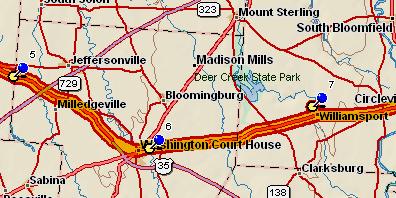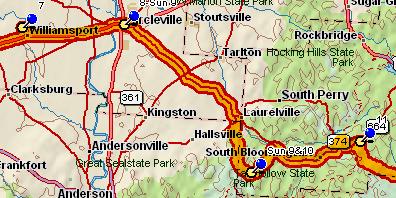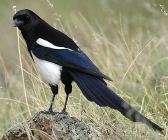A Crossing Between Worlds
From Jamestown the old road wound and rolled over the contours of the land for several miles, in much the same agreeable way that it had done on its approach to that town.
 Then it merged into the new, divided highway leading to Washington Court House — the next small city on my route — and suddenly it was flat, nearly straight, and semis were roaring along it. Corn and soy fields alternated, with a sprinkling of trees here and there. I fear it would have been a long dull hike had my feet been sound!
Then it merged into the new, divided highway leading to Washington Court House — the next small city on my route — and suddenly it was flat, nearly straight, and semis were roaring along it. Corn and soy fields alternated, with a sprinkling of trees here and there. I fear it would have been a long dull hike had my feet been sound!
I stayed the night at a motel in Washington Court House (“settled by veterans of the American Revolutionary War!”), and headed east-by-northeast out of town. Here I was on a minor, two-lane road, but the land was still flat — scraped flat by some ancient ice sheet — and once I got past the suburban stretch of houses along the road just out of town, corn and soy fields still predominated.
The distance from Washington Court House to Circleville (my next goal) was too far to be walked in one day, so I’d planned to find a field to camp in overnight. I now saw that this would have posed challenges. The fields were tilled and planted clear to the margins, leaving no space for a campsite. And everything was open to the road: on this flat landscape, with so few trees, it would have been very difficult to tuck a camp out of sight.
Thus I’d have needed to get permission to camp in a farmer’s yard — but the farmers’ yards were all in the fronts of their houses (nothing in back but corn and soy fields) and were utterly flat, wide open to the street, and perfectly manicured. I suspect I’d have had to find a quite exceptional farm family to get permission to camp on one of those perfectly kept, utterly visible yards.
Ah, well. I did have a car now. After a sweltering walk in the July sun — as much as my feet would handle — and a fruitless attempt to find a campsite at a state park a dozen miles off my route, I opted for another night in yet another cheap motel.
And now another sweltering day of walking, driving, and sitting with more of that same flat corn-flooded landscape. I was impressed to see that some of the corn I was passing was now a good three-and-a-half feet high — a foot taller than the tallest corn had been just one week earlier! — and the tassels and tiny, growing ears were now plainly visible. I paused by a pretty little creek at Williamsport, crossed another long flat stretch of road through corn fields, and found myself at the Scioto River, with Circleville on the other side.
Here in this little city, a tiny unprogrammed worship group has gathered around two dedicated local Friends. One of these two was unable to meet with me, but the other, a local doctor, managed to free up a couple of hours from his busy schedule on the morning after my arrival, in order to talk with me over breakfast.
This Friend’s vehicle sported a bumper sticker — “Jesus was a liberal” — and he repeated the slogan to me orally at the conclusion of our breakfast. He talked of his anti-war activities in town. We didn’t do a called meeting for discernment regarding my environmental questions; his circumstances would have made that an imposition on him, and I truly didn’t want to impose. But we did discuss the questions, and he encouraged me to work for a strong and meaningful Friends testimony on the environment.
 Now I was come to the edge of the Midwest. My route turned sharply southeastward, and halfway from Circleville to the twin towns of Laurelville and Adelphi, as I crossed the little hamlet of Leistville, low hills began rising up in a semicircle all around the horizon before me. The land ahead opened in vistas reminiscent of a sort of miniature Vermont — hills like tiny rounded mountains, separated by broad glacier-rounded valleys, with prosperous farmhouses and vacation homes scattered about.
Now I was come to the edge of the Midwest. My route turned sharply southeastward, and halfway from Circleville to the twin towns of Laurelville and Adelphi, as I crossed the little hamlet of Leistville, low hills began rising up in a semicircle all around the horizon before me. The land ahead opened in vistas reminiscent of a sort of miniature Vermont — hills like tiny rounded mountains, separated by broad glacier-rounded valleys, with prosperous farmhouses and vacation homes scattered about.
At Adelphi (“Adelphee”), I hit the beginnings of Appalachia with an almost physical sense of impact. You can maybe get a sense of the drama of the transition from the map below, where my route is represented by the orange line crossing from left to right. Tiny hills crowded up on every side of me, with unbelievably steep slopes — rocky edges of the dissected Allegheny Plateau — thickly wooded, green and moist and lush, cushioned with loamy soils and ferns and mosses.

Oh, what a change from those cornfields!
My route veered southward and plunged into a narrow, winding valley: almost a canyon, the hillsides crowded it so. Vacationers’ houses and urban retirees’ houses stood jowl-by-cheek with the humble homes and rusting junkers of native mountaineers. Again and again I saw the carrot-colored hair and wiry build of the Appalachian Scots-Irish.
And how the land was speaking to me! Here I could see habitat suitable for whole nations of birds and smaller mammals, sidling all the way up to the eaves of the houses. Grass and shrub species grew in profusion side-by-side, shaping one another’s destinies. Here was a community of natural life, diminished to be sure from before the arrival of the settlers, but still rich and healthy. This land was not lonely the way the corn seas had been.
Mile after mile up and down the slopes of that side road: how I’d have loved to walk this bit. It was almost another planet.
A left turn up a side road, a second left, and I’d reached my destination: a bed-and-breakfast, the only likely-looking housing I’d been able to spot before leaving home at anything like a walkable distance along my route out of Circleville. I’d have been half-dead by the time I arrived there on foot, of course; it was twenty miles from where I’d been the previous night. But such a worthy goal!





Reader Comments (1)
I drove up and down rte 23, first through and later around Circleville, between Detroit and Huntington, WV, where Lee taught. A little ways above Circleville is the roadside Renick's Farm Market, which has expanded from one booth in the 50s to a large room which offers fresh local produce, local packaged items (baked goods, canned vegetables, honeys & jams), and some imported beverages (I frankly like being able to buy good old straight sugar-water Jarritos soda from Mexico here). They have a big corn maze at Halloween and then close till spring. They sell a lot of corn for people to eat. It's a mixed-use place that gives one hope.
Few people realize that SE Ohio is Appalachian. Thanks for pronunciation of Adelphi. There's a town in WV, New Canaan, pronounced "kuh-NANE." That suggests not just a dialect, but the pronunciation of a familiar place name by someone who lived in relative isolation but certainly read their Bible, and thus had never heard Canaan pronounced, but could see in reading that it had two 'a's in it.
Sometimes the good places to camp in such places, are there but not evident. They've been preserved, but are not on the main line. Or the main line no longer takes one to them, as the old "desire lines" would. M-12 in Michigan, of course, is one of the nicest desire lines in the country.